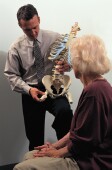
THURSDAY, Jan. 2, 2014 (HealthDay News) — A new medication for osteoporosis prompts the body to rebuild bone and could potentially strengthen the skeleton against fractures, researchers report.
The experimental drug, romosozumab, frees the body’s ability to stimulate bone production by blocking biochemical signals that naturally inhibit bone formation, explained Dr. Michael McClung, founding director of the Oregon Osteoporosis Center in Portland, Ore.
The treatment is one-and-a-half to three times more effective than current osteoporosis drugs in rebuilding bone density at the lumbar spine, according to clinical trial results McClung and his colleagues reported in the Jan.1 online edition of the New England Journal of Medicine.
“Most osteoporosis drugs work by stopping the progression of bone loss, but they don’t have the capability of rebuilding the skeleton,” McClung said. “This really is a new day in the consideration of how we treat osteoporosis, with the capability of truly stimulating bone production and rebuilding the skeleton, not simply keeping it from getting worse.”
More research is needed, however, before romosozumab is approved to treat osteoporosis, a serious bone-thinning disease, in the United States.
The new drug uses an antibody to block the function of sclerostin, a protein the body produces to naturally inhibit bone growth.
Without sclerostin, overactive bone growth might clamp off nerves or end up fusing the spinal column, said Dr. Robert Recker, president of the National Osteoporosis Foundation and director of the Osteoporosis Research Center at Creighton University in Omaha, Neb.
But sclerostin also prevents people with osteoporosis from building additional bone density to replace the bone that has been lost.
The antibody romosozumab binds to sclerostin and prevents its signal, which allows pro-bone-growth signals to proceed uninterrupted, the researchers explained.
This phase 2 clinical trial involved more than 400 postmenopausal women aged 55 to 85 who had osteopenia, which is low bone mass that is not low enough to be classified as osteoporosis. They were randomly assigned to receive one of four treatments for a year: romosozumab; a placebo; or one of two current osteoporosis medications.
Results showed that romosozumab increased bone mineral density in the spine by 11.3 percent during the study period, compared with a 7.1 percent increase with teriparatide (Forteo), a current osteoporosis treatment. The new drug also performed much better than alendronate (Fosamax), a bisphosphonate medication that increased spinal bone density by 4.1 percent.
“In terms of rebuilding bone mass, this is clearly better than Forteo or the bisphosphonates,” said Recker, who was not involved with the study.
The new drug also appears to be safe, with no major side effects reported, McClung said.
Recker expects that the antibody medication will prove safe because the bone-building signals that are left uninhibited by the drug will taper off naturally as the skeleton becomes better able to withstand weight loads and stresses. “I think it’s going to be self-regulating,” he said.
The drug is still several years from coming to market, McClung noted. Researchers have to prove to the U.S. Food and Drug Administration that it actually protects against bone fractures, which will require more research.
But onlookers are enthusiastic regarding the potential of romosozumab.
“This possibly represents the most important change in treatment of osteoporosis that we’ve seen,” Recker pointed out. “We’ve not been able to have a strongly bone-building product available to us. There’s no reason not to believe it will prevent fractures, but that has to be proven.”
According to the National Osteoporosis Foundation, half of all Americans over age 50 are expected to have low bone density or osteoporosis by 2020.
More information
For more information on osteoporosis, visit the U.S. National Library of Medicine.
Copyright © 2025 HealthDay. All rights reserved.

